Thomas Bertram Murray-Prior and his siblings
Matilda and Thomas had 12 children, of whom only five had children and only two had any grandchildren. The children of Thomas de Montmorenci and Florence M-P were:
1. Florence (known as Florette) Elizabeth M-P, was born at Bowen, Queensland on 1 January 18791) and baptised there by the Rev. M. Ross2). It is likely that, to ensure greater safety with her first birth, she was visiting her mother and stepfather there rather than living there. Florette died in Sydney on 12 July 1956.3)
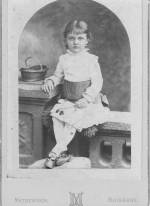 Young Florette.4) Is this the photo that TLM-P refers to in his 1888 diary when he notes that on 10 July Florence had 'an appointment with Malthers for [9 year old] Florette's photograph'?))
Young Florette.4) Is this the photo that TLM-P refers to in his 1888 diary when he notes that on 10 July Florence had 'an appointment with Malthers for [9 year old] Florette's photograph'?))
Like her sisters, she was educated at Ascham, an elite school in the Eastern Suburbs of Sydney,Ascham.5)
On 28 October 1896, the poet/novelist James Brunton Stephens wrote to her encouraging her to persevere with her poetry, but advising she defer publication.6) Prominent feminist Rose Scott also wrote to Florette encouraging her artistic talents.7) In the end, Florence decided on music, with a New Zealand paper reporting in 1906 that she planned to go to Paris for further study.8) Her farewell concert was held in April 1906.9) In 1909 it was announced that she would be part of the Alys Bateman Concert Company to tour New Zealand the following year.10) When she returned to Australia in 1909, she was described as a contralto who had been overseas for 4 years, having studied for 2 of those years in Paris under the famous baritone Jacques Bouhy11) Her talent as a singer was something she shared with her mother.12).
The following photo and description of Florette and her daughter Diana's talent as singers was published in the Queensland Geographical Journal 13): 
It is not known if she did tour New Zealand, but in August 1910, Florette married Sydney (Syd) Charles Edgar Herring.14) His sister Estella was married to Florette's step-uncle, Robert Sterling M-P. Sid Herring was an estate agent at Gladesville. He distinguished himself during World War I, rising to the rank of Brigadier General.15) Florette followed him when he went overseas,16) undertaking volunteer war work. Max Barton wrote in 1917 that he thought she was assisting (in what capacity it is not known) at a hospital in Harrow (England).17) She took her little daughter with her overseas, first to Cairo then England.
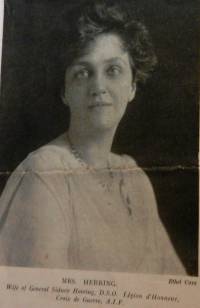 This photo of Florette was published in The Ladies' Field, 16 November 1918, p.304. She was described as a supporter of the British Women's Patriotic League, and as having recently organised an Australian stall at a fund-raising sale.
This photo of Florette was published in The Ladies' Field, 16 November 1918, p.304. She was described as a supporter of the British Women's Patriotic League, and as having recently organised an Australian stall at a fund-raising sale. 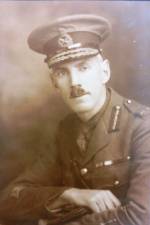 Her husband Sydney Herring. In November 1917, Colonel Herring was appointed to a training school on Salisbury Plains, so Florette and her daughter joined him in England. This is a photo of Syd during the war.
Her husband Sydney Herring. In November 1917, Colonel Herring was appointed to a training school on Salisbury Plains, so Florette and her daughter joined him in England. This is a photo of Syd during the war.
Florette's strong-mindedness tended to be viewed with alarm, if not hostility, by the younger male members of the family. Nora M-P's nephew R.A. (Max) Barton was very sociable when on leave in London during World War I, but complained each time he felt duty-bound to visit Florette. That she campaigned (in the UK) for women's suffrage did not help him view her any more favourably, writing after one visit in 1917 that he'd 'listened to the success of her suffragette campaign in Ireland till I was sick … I was quite relieved to hear that Mrs Herring had, on receipt of report of above mentioned campaigns told her not to be a fool and to waste her time on such rubbish.' 18) Presumably 'Mrs Herring' was her mother-in-law. After the war, Florette continued to be viewed with trepidation partly because she was an energetic organiser of social events19) - the steely resolve evident in her childhood photo did not leave her! Her husband Syd appears more sympathetic, with their wartime letters indicating that they enjoyed a happy marriage.
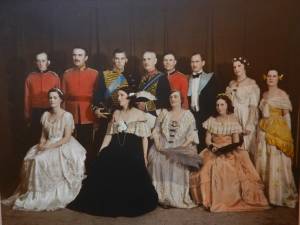 The theme of this ball was The Living Army and it was held in 1932. Florette is 3rd from left in the front; E. Sterling Murray-Prior is third from left at the back; Syd Herring is 4th from left. My recollection is my father (Sterling) telling me that he attended the ball dressed as he was under duress from Florette.20)
The theme of this ball was The Living Army and it was held in 1932. Florette is 3rd from left in the front; E. Sterling Murray-Prior is third from left at the back; Syd Herring is 4th from left. My recollection is my father (Sterling) telling me that he attended the ball dressed as he was under duress from Florette.20)
Syd and Florette had one child - information about her is available on request to family members.
For other photos, click on Florette
2. Mabel Penelope M-P, M.A., Ch.M.(Sydney University) 10 September21)1881 - 9 January 1932. She was born at Ipswich, perhaps on the property that, in 1880 at least, was owned by her grandfather TLM-P: Pullen, Moreton, Ipswich.22) She was baptised at Ipswich by the Rev. Mr Heath.23) Her Sydney University records states that she went to school, presumably as a boarder, at Ascham.
A young, somewhat idealised Mabel 
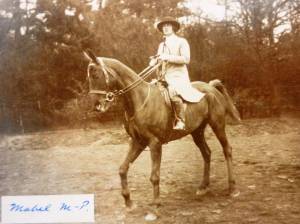 24)
24)
An obituary published by the Women's College at the University of Sydney outlines her chequered academic career.25) She was the 41st student to enter the Women's College in 1899 while she studied for an Arts degree. She left after a year with second class honours in French. She returned to the University in 1903 to study medicine; it was a time when higher education was still controversial for women, and medicine particularly so. Medicine had a high failure rate and Mabel left, having only completed the third year of the course, in early 1907. She returned in 1911 in an attempt to finish, but left after a term. It is not known what she did then, though she was probably the 'Miss Murray-Prior' who unsuccessfully applied for the position of Superintendent at the Sydney Medical Mission in December 1911. She was not appointed because she was not medically qualified.26)
In January 1914 Rosa Praed wrote how she was pleased Mabel had had 'an extremely good time … [and] some English hunting' and was about to leave for home with Mary Bundock, Thomas de M. M-P's second wife.27) Mabel took her time returning as, when World War I began in July 1914, she was in Hong Kong. She then returned to England and qualified in 1915 as a V.A.D. (Voluntary_Aid_Detachment) - as did her cousins Ruth M-P and probably Dorothy M-P. In December 1914, Ruth wrote that Mabel was accompanying her sister Florette to Europe: most likely when Florette was trying to see her husband Sydney Herring who was on active duty.28) Mabel subsequently worked as a VAD in an unnamed English hospital. Dublin University was one of the few universities that admitted women, and she went there to complete her medical degree. After qualifying as a doctor, she was a medical resident for 6 months at the Royal Herbert Military Hospital in Woolwich, London then moved to Edinburgh Hospital, Scotland where she worked until mid-1919. In 1917, she was awarded a Doctor of Medicine at University of Edinburgh.29)
There is a letter dated 19 January 191530) from Ruth M-P to Rosa, saying that Mabel was engaged: if so, it was unofficial as another family member thought she was 'only fooling', and had booked to go to Japan, 'sans the man'.31) Her family viewed Mabel as eccentric: her aunt Rosa Praed, for example, wrote to Ruth M-P after Mabel qualified as a physician: 'I suppose from Mabel's point of view it is a good thing, but I can't help feeling sorry for her patients. No doubt, however, the soldiers will adore her and she may put her best self into their ills.'32) Others were more forthright. Max Barton wrote to his mother in 1916 referring to Doris Kennedy, an Irish cousin: 'I did hear that Doris’s housekeeper expressed the opinion that Mabel M.P. was mad.'33) Nevertheless, the extended family remained close and when Mabel wrote to Nora M-P, her father's stepmother, it was to 'My dear Grandmother Nora'.34) Another sign of the closeness between the step-relatives is that, after her death, C.B. Darvall, one of Nora's relatives, acted on behalf of Mabel's two executors (her elder siblings Thomas and Florette).35)
In 1928, Mabel was living in two caravans in Middlesex, with her address 'Nomad's Camp, Splash Road, Shepperton'. The Staines District Council took her to court claiming she did not have a proper facilities for water or the disposal of waste. She told the court she lived in one caravan with the other used as kennels, and that she did have adequate arrangements: charges were dismissed.36) Mabel's step-cousin Dorothy (Dorothea M-P) wrote that Mabel visited Australia around 1921 for a visit: 'After that she travelled for some years before settling down to country life in England and in Ireland. She was a keen sportswoman and took great pleasure in hunting and in breeding dogs. In 1931 she was taking a course in gynaecology in Dublin. We saw her in Ireland before we left for Australia. She was then in poor health after a bad fall. Subsequently pneumonia set in and although news was cabled that she was recovering, there was a sudden relapse. She died in hospital. She was a brave, vivacious and warm-hearted woman, and we have found very many friends who mourn her passing.'37) The Daily Telegraph, when reporting her death, described her as 'a lady of brilliant intellect and vivid personality and had a good [medical] practice and a large circle of friends'.38) Mabel's support for the British Empire is evident by her 1924 Certificate of Fellowship of the British Empire Exhibition.39)Bernard Burke, A Genealogical and Heraldic History of the Colonial Gentry, Melbourne: E.A. Petherick, 1891-95, p.50.))
3. Thomas Bertram M-P, (4 February 1883 - 25 August 1946). 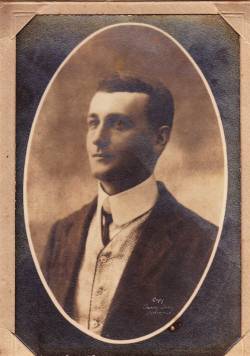 Thomas B. M-P taken by professional photographer in Brisbane.40)
Thomas B. M-P taken by professional photographer in Brisbane.40)
Thomas Bertram was Thomas de Montmorenci and Florence M-P's third child and only son. He was the 5th consecutive Thomas Murray-Prior. His mother unsuccessfully tried to subvert the tradition of calling the first-born son Thomas - she called him Bertie, though it seems the rest of the family stuck with Tom. TLM-P and his aunt Rosa Praed were godparents.41) There is confusion over his place of birth. TLM-P wrote that Thomas Bertram was born at Moonbago Station, South Kennedy, Bully Creek, a station owned by TLM-P.42). Matthew Fox 43) states he was 'born on “Bulliwallah” Station, Northern Queensland'. Thomas Bertram's death certificate, which did not have a family member as an informant, assumed he was born at Maroon. It is most likely that TLM-P was correct, and that he was born at Moonbago Station.
Matthew Fox 44) claims that Thomas Bertram was educated at Armidale, NSW, until he was 18 years old. If so, the school he attended was almost certainly The Armidale School (TAS). Thomas Bertram then returned to Maroon Station, and a year later his father died. Thomas B. M-P was 'one of the trustees of the estate', and 'became manager until (most of) the property, which originally comprised 10,000 acres, was sold for purposes of closer settlement.' Thomas B. M-P kept the old homestead, with 600 acres of land, 'with its picturesquely wooded hills and well-grassed pasture lands.' He mainly used the remaining land to breed 'shorthorn cattle from stock originally introduced by his late father' and stock imported from New Zealand, 'the progeny from which have been frequent prizewinners at Brisbane shows.' In the early 1920s, when Fox was writing the entry, Thomas Bertram had a stud consisting of 'about 50 cows of the finest shorthorn type'. In addition, he was planning to introduce mixed farming to Maroon. The success of Thomas Bertram's stud is indicated by the sale of two bulls in 1914 for, respectively, 32 and 110 guineas (in 2022 values, the latter is around $22,185).45)
Fox also states that Thomas Bertram was a Justice of the Peace and during 1914-17 was an elected member of the Goolman Shire Council46) and on the committee of the Boonah Agricultural Society.47) While his father donated the land for the first Maroon School which opened in 1891, mainly for the children of settlers taking advantage of the closer settlement acts, it was Thomas B. M-P who chaired the first committee to establish the school.48)
One account suggests that Thomas B. M-P was sympathetic towards the indigenous owners of the land. What became known as the last great corroboree of the local tribes was held at Maroon in 1905. As Thomas B. M-P owned Maroon then, the Aboriginal participants would have had his permission to congregate. The recollection is second hand (a man recounting his then 11-year old mother's memory 68 years later), but states that the local settlers were part of the audience and contributed food. The corroboree featured a huge bonfire and traditional dances 'The Hunt' and the 'Dying Kangaroo“.49)
For photographs of the family at Maroon that, from the women's clothes, appear to be in the 1910s, click on Maroon.
 Card featuring St Andrew's Church, Maroon - the M-Ps, presumably Thomas B. M-P, were responsible for its erection in 1907.50)
Card featuring St Andrew's Church, Maroon - the M-Ps, presumably Thomas B. M-P, were responsible for its erection in 1907.50)
On 18 February 1911, Thomas B. M-P married his cousin, Elizabeth Katherine (Lizzie Kate) Lightoller (29 October 1887—21 January 1949).51) her name causes confusion: she was registered as Lizzie Kate but the name she gave in her husband's death notice was Elizabeth Katerine. She was commonly known not only as 'Dickie' but also 'Elsie' - the latter name was used in her marriage and death notices in the newspaper.52) She was the daughter of well-known Brisbane physician, Dr Henry Lightoller. Dr Lightoller's grandmother was Rosa Haly (nee Harpur), Matilda M-P's sister.53) Thomas B. and Lizzie M-P had four children - see next generation listed on this website.
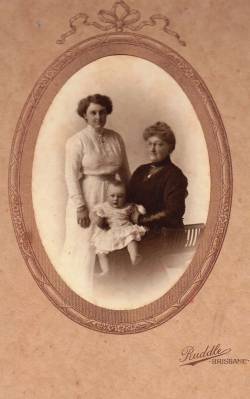 'Dickie' M-P, her mother Maria Theresa (Minnie) Lightoller (nee Haly), and Dickie and Thomas B's eldest son. For more photos of the Lightollers, click on **Lightoller**
'Dickie' M-P, her mother Maria Theresa (Minnie) Lightoller (nee Haly), and Dickie and Thomas B's eldest son. For more photos of the Lightollers, click on **Lightoller**
The Lightollers, Dr Henry and Minnie Lightoller, were family friends as well as relatives, though Nora M-P strongly disapproved of Dr Lightoller's attitude to pain relief in childbirth. He refused his wife Minnie chloroform until he needed to use instruments to birth the baby. Nora, as she wrote to Rosa Praed, considered 'Dr Lightoller is a staunch opponent of Chloroform tho' his chief argument against it seems to be the cowardice of taking it which I think is a question for the sufferer to decide, and could not help telling him what I felt keenly, that were it a misfortune to which both sexes were liable chloroform would have been given long ago. He looked astounded at my venturing to discuss the subject, looking on it as becoming in a man and a doctor to lay down the law – for women ‘theirs is not to reason why – theirs but to suffer and die - a view of the case against which I, as one of the suffering class. protest vehemently. He is a good little dogmatic man, skilful in his degree and he has the best wife that ever trod shoe leather - but I wish she would not be so submissive as regards chloroform.’ Nora went on to say that Minnie told her 'that she had been 12 hours in the most fearful agony, at the end of which they had given her chloroform which had brought it on so they could use instruments'. Nora's view was that she 'would want to know a very good reason why before I would suffer like that in deference to my husband's general principle and it stands to reason that she would recover better if she were not so long ill and in pain'. She was indignant that Dr Lightoller had made Minnie promise not to expect chloroform unless it was necessary for him to use instruments.54) The reasons for Dr Lightoller's reluctance to use chloroform may have been due to common religious view that women were ordained since Eve to give birth in pain, and/or due to concern for its safety. It was also in keeping with the general reluctance of Brisbane Hospital doctors to use anaesthetics even for amputations and other major surgery even years after its use was routine elsewhere.55)
It was probably Lizzie M-P who was one of the three trustees for the Maroon School of Arts after it was built in 1903-04: the Maroon booklet says “Mrs T.A. Murray-Prior', presumably a misprint for Mrs T.B M-P as Thomas B. M-P was one of the Presidents of the School of Arts. In the early twentieth century, the local settlers also played tennis on the court at Maroon homestead.56) In later decades, the area would look back with nostalgia at the happy social days at Maroon: 'During the regime of the Murray-Priors, dances, picnics and riding parties were the order of the day. many of the young people of Brisbane making the long journey by train and biggy to join in these festivities',57)
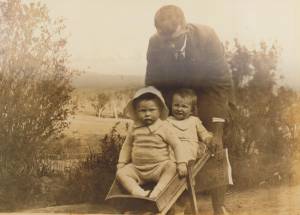 This photo is dated c.1914-15, and is of Thomas B. (still clutching his copy of the Pastoral Review) at Maroon with his eldest son and the latter's cousin, Minnie Palmer.58)
This photo is dated c.1914-15, and is of Thomas B. (still clutching his copy of the Pastoral Review) at Maroon with his eldest son and the latter's cousin, Minnie Palmer.58)
For more family photos of Thomas B. and Lizzie Kate M-P click on Thomas B. & Lizzie.
By Thomas B. M-P's time, the district around Maroon was no longer isolated. In 1914, the property was subdivided with Thomas B. M-P retaining the portion with the homestead on it. The auction on 20 April 1914 brought in around £27,000 with an average price of just over £3 per acre. Thomas B M-P privately purchased the homestead lot of 608 acres at £7/2/4/ an acre; while two adjoining lots were respectively purchased by his sister Ethel (Mrs W.B. Butler - 205 acres at £3/5/0) and 'Miss Murray-Prior' (another of his sisters? 172 acres at £4/7/6).59)
In November 1920, Thomas B. M-P sold his remaining section of Maroon.60) There are numerous family stories about why, though nothing certain. A probable factor was his sight: he was badly injured when mustering cattle on the station in 1914, with the result that one of his eyes had to be removed.61) Another factor is that, by the end of World War I in 1918, the area was grief-stricken and deprived of many of its young men who provided the local labour. Maroon had the sad distinction of having the highest casualty rate of any community in Australia during that War: from a small number of families, 42 men enlisted, including 8 sets of brothers. Of these 42 men, 17 (40%) died. Unless Maroon men were exceptional, the rest returned nursing psychological and physical wounds.62)
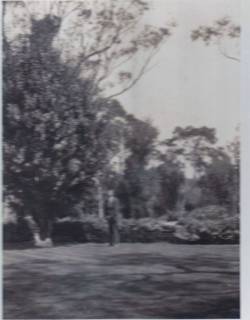
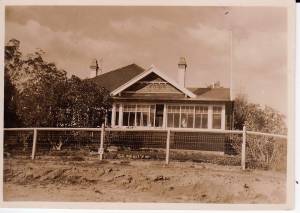
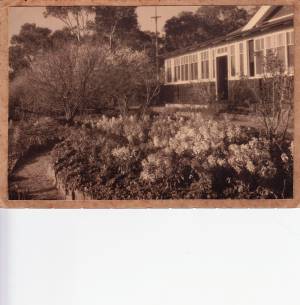 Three views of Birrilli, home of Thomas B. and Lizzie M-P. The first indistinct photo is of Thomas B. M-P in the garden.63)
Three views of Birrilli, home of Thomas B. and Lizzie M-P. The first indistinct photo is of Thomas B. M-P in the garden.63)
After selling Maroon, Thomas B., Lizzie and their children moved to Southport.64) Around 1924, they moved again, to 'Birrilli', Kensett Avenue, Leura in the Blue Mountains west of Sydney. It was thought that the climate would be healthier for their youngest son Hugh who had contracted polio. In 1937 Thomas B. was elected to the Leura Urban Committee.65)
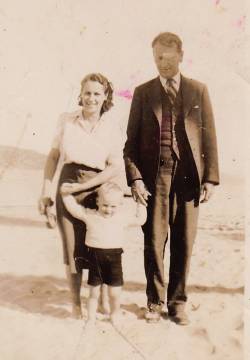 Three generations of M-Ps: Thomas B. M-P, his daughter-in-law and her eldest son. Thomas B. is dressed in conventional business attire of the 1940s: it made few concessions to the Australian climate!
Three generations of M-Ps: Thomas B. M-P, his daughter-in-law and her eldest son. Thomas B. is dressed in conventional business attire of the 1940s: it made few concessions to the Australian climate!
Thomas B. and Lizzie separated around the end of the war or shortly after, with Thomas B. reputedly leaving with the nurse hired to look after polio-affected young Hugh. Thomas B. did not enjoy his new relationship for long. His death certificate revealed that he had had high blood pressure for around 20 years and, for his final year of life, the related and painful kidney condition of malignant nephrosclerosis. Thomas B. died on 25 August 1946.66) His last address was Irish Harp Road (now Regency Road), Prospect, Adelaide, South Australia. Probate - along with the family money - was granted to Stella Gilmore Prior.67) It is believed that Stella later returned to her homeland New Zealand, possibly with her and Thomas's child, though no such child was noted on his death certificate.
A search of the New Zealand papers reveals a mystery. There are reports of visits to that country by Thomas B. and his wife on several occasions before and during World War I.68) Even odder are the reports that Thomas B. M-P stayed there, apparently for over a year, in 1935-36,69) then left for Vancouver.70) Was this another Thomas B. M-P, a misprint, or unexplained activity in New Zealand?
4. Ethel Nora M-P, 1 December 1884-1959. She was born at Moonbago Station, South Kennedy, Bully Creek, a station owned, at least in 1880, by her grandfather TLM-P.71) She was baptised at All Saints Church of England, Brisbane.72)
Ethel married William Royston (Roy) Butler in 190973) and they lived on his father's property 'Staghurst', Toogoolawah in Queensland which Roy managed. In his history, Fox states that Roy Butler also managed another of his father's properties at Kilcoy.74).
This photo is of Ethel is as a bride.75) 
Ethel and Roy had five children. Ethel wrote 3 letters in 1933 about her family history. These are in the Fryer Library, University of Queensland. If anyone is in Brisbane and could see them, all information gratefully received! The library reference is Letters, 1933 : Toogoolawah, Ethel Butler to A. J. McConnel, Item F808. Ethel was musical like her sister Florette. She went to the trouble of binding her music together in a volume embossed with her name 'E. Butler'. On this sample page, she wrote her name and 'New York 1907', suggesting she obtained it there. 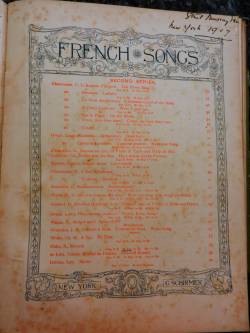 76) Ethel visited her aunt Rosa Praed in England in 1906 and maintained a loving relationship by letter after that. On 12 December 1913, Rosa wrote that she shall 'never forget the time you were with me & the sympathy & rapprochement of that little fortnight which makes me regard you in a closer way than any other of my nieces.'77)
76) Ethel visited her aunt Rosa Praed in England in 1906 and maintained a loving relationship by letter after that. On 12 December 1913, Rosa wrote that she shall 'never forget the time you were with me & the sympathy & rapprochement of that little fortnight which makes me regard you in a closer way than any other of my nieces.'77)
5. Phyllis Claudia M-P (23 July 1886 - 1957). She was born at Maroon and baptised at All Saints Church of England, Brisbane by the Rev. M Robinson.78). She and Edgar Cannon McConnel married in 190979) and lived for most of their marriage on the McConnel family property Cressbrook, near Toogoolawah in south-west Queensland - close to where her sister Ethel lived after her marriage. Phyllis and her husband were both buried at Cressbrook.80) Phyllis and Edgar had four children.
Edgar McConnel was an outstanding horseman and helped train the Australian Light Horsemen during World War I.81) Noted anthropologist, Ursula McConnel, was Edgar McConnel's sister, and thus became Mary M-P's (Thomas de M. M-P's 2nd wife) step-niece: different generations of anthropologists of Aboriginal life connected to the one family.
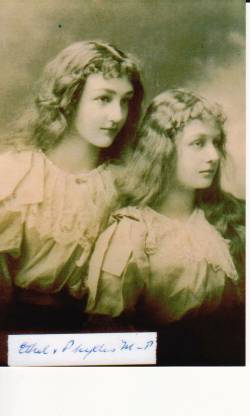 The two younger sisters.82) Phyllis when older.83)
The two younger sisters.82) Phyllis when older.83) 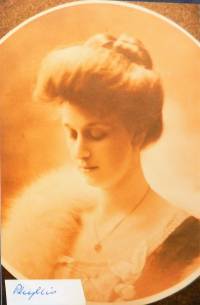
The close ties of family is illustrated by this photo,
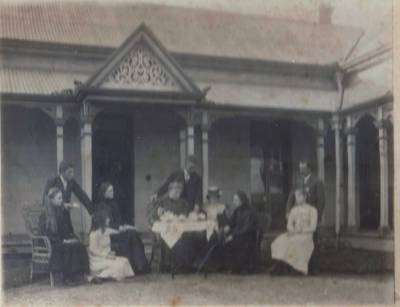 On the back of this photo is written that it shows a surprise party to wish Ethel M-P a happy Xmas and glad new year, Xmas 1901. The old woman in the centre is understood to be Mary Bundock.84) Mary Bundock left a legacy of ₤200 to Helen McConnel, her step-granddaughter and god-daughter.85)
On the back of this photo is written that it shows a surprise party to wish Ethel M-P a happy Xmas and glad new year, Xmas 1901. The old woman in the centre is understood to be Mary Bundock.84) Mary Bundock left a legacy of ₤200 to Helen McConnel, her step-granddaughter and god-daughter.85)